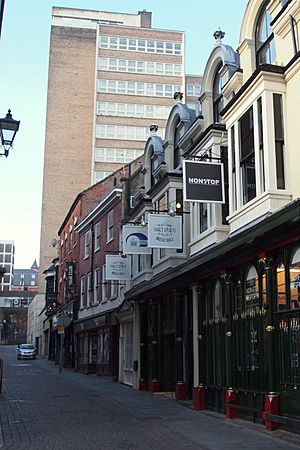Malt Cross facts for kids
The Malt Cross is a special building in Nottingham, England. You can find it on St James Street, right in the heart of Nottingham city centre, close to the Old Market Square. This building was built way back in 1877. It's one of the few Victorian music halls that are still standing today!
For many years, it was a popular café bar where people enjoyed live music. It closed its doors on July 18, 2018. However, good news came on August 15, 2018, when it was announced that the Malt Cross would reopen. This happened in September 2018, thanks to a new team-up between its owners and the Nottinghamshire YMCA.
The building gets its name from an old monument. This monument used to be in the market square and was a popular meeting spot. A writer named William Howie Wylie once mentioned that a stonemason named John Nelson, who followed John Wesley, preached there. He preached once in the market place and another time at the Malt Cross monument.
A Look Back: The History of the Malt Cross
The original Malt Cross monument was cleared away in 1806. Records from that time show that the area where the monument stood was cleaned up and repaired. An old pump was also removed from the spot.
The Malt Cross building we see today was constructed in 1877. Before it became the Malt Cross, the site was home to an inn called the Roebuck. A man named Mr. Charles Weldon bought the Roebuck. He then rebuilt and made the building much bigger, turning it into the music hall.
Mr. Charles Weldon managed the music hall for only a few years. In 1880, he lost control of it because of a large loan. After that, the Malt Cross had many different managers. For example, Mr. William Hulse was in charge from 1883 to 1889. Later, Mr. Arthur B. Johnson managed it for a longer time, from 1893 to 1900.
The Amazing Design of the Malt Cross
The person who designed the Malt Cross building as it looks now was Mr. Edwin Hill. The most impressive part of his design is the tall, arched glass roof. The wooden arches that support this roof are very special. They are made from many layers of wood glued together. The inner arches have ten layers, and the outer ones have twelve.
This layered design made it possible to bend the wooden beams into the perfect curve. It also avoided the usual problems that came with designing wooden arches back then. You can't see any nails or bolts holding the layers together. People believe they are held firmly in place by glue alone!
See Also
- Listed buildings in Nottingham (Bridge ward)


